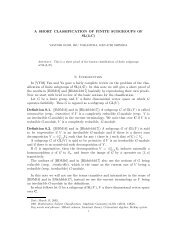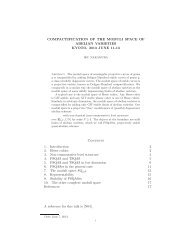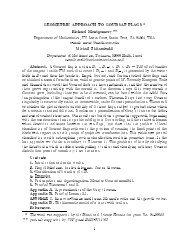mckay correspondence iku nakamura
mckay correspondence iku nakamura
mckay correspondence iku nakamura
- No tags were found...
Create successful ePaper yourself
Turn your PDF publications into a flip-book with our unique Google optimized e-Paper software.
MCKAY CORRESPONDENCE 113.8. The ideals n X and π ∗ m. Since (A 2 /G) × ( 2 /G) X ≃ X, X is a closedsubscheme of (A 2 /G) × X, which is defined by an ideal I X of O 2 /G ⊗ O X .Let n X be the ideal of O 2 ⊗ O X generated by I X . Let Z univ be the universalsubscheme of A 2 × X, and I univ the ideal sheaf of O 2 ×X defining Z univ . Sincewe have a commutative diagrampr 2Z univ −−−→ X⏐ pr 1⏐↓⏐π↓A 2φ−−−→ A 2 /G,the morphism φ × id X : A 2 × X → A 2 /G × X sends Z univ into (A 2 /G) × ( 2 /G)X ≃ X. This implies that n X = I X O 2 ⊗ O X ⊂ I univ . Now we defineV := V (I univ )=I univ /mI univ + n X .Let m be the maximal ideal of O 2 /G of the unique singular point. Wenote n =Γ(A 2 ,φ ∗ m). We also note π ∗ (m) ∩ I univ = {0}. In fact, supposeπ ∗ (F ) ∈ I univ . Then π ∗ (F )=0onZ univ . Since Z univ is surjective over A 2 /G,F = 0. It follows π ∗ (m) ∩ I univ = {0}.Since π ∗ m := mO X is the defining ideal of E fund by [Artin66], we see thatV is a finite O Efund -module. See section 6 for the proof. However we prove alittle strongerTheorem 3.9. The O 2 × X-module V is a finite O E -module; as an O 2 × X-module with G-action, we have an isomorphismV≃ ⊕ρ ⊗ O E(ρ) (−1).ρ∈Irr GIn section 6 we will prove Theorem 3.9. In order to prepare for the proofof Theorem 3.9, we recall in section 4 the proof of Theorem 3.4 and relatedconstructions in the case of D 5 in full detail. In the cases D n (n ≠ 5) and E 6we give only a sketch of proofs of Theorem 3.9. Though we give almost noproof for E 7 because we need more notation, we remark that we can prove itin the same manner. It remains to check E 8 .4. The Simple Singularity D 5In this section we explain the case of D 5 in full detail.4.1. The binary dihedral group D 3 . The simple singularity D 5 is thequotient singularity of A 2 by the binary dihedral group G := D 3 of order 12,which is generated by σ and τ:σ =( )ɛ 00 ɛ −1 , τ =( )0 1,−1 0where ɛ := e 2πi/6 . We have σ 6 = τ 4 =1,σ 3 = τ 2 and τστ −1 = σ −1 . Thering of G-invariants in C[x, y] is generated by three elements A 6 := x 6 + y 6 ,





